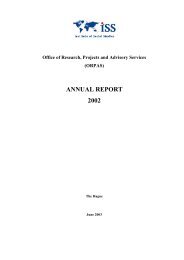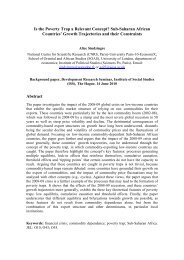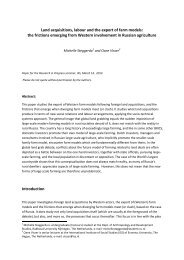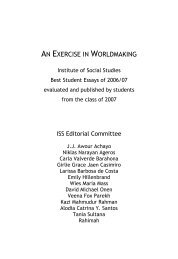AN EXERCISE IN WORLDMAKING 2009 - ISS
AN EXERCISE IN WORLDMAKING 2009 - ISS
AN EXERCISE IN WORLDMAKING 2009 - ISS
You also want an ePaper? Increase the reach of your titles
YUMPU automatically turns print PDFs into web optimized ePapers that Google loves.
164 UMME BUSRA FATEHA SULT<strong>AN</strong>A<br />
out of segregated living spaces, and was thus introduced as a symbol of<br />
independent privileged upper class women who were no longer dependent<br />
on male relatives to go out.<br />
However, the symbol of burqa in present days is entirely opposite<br />
from what it used to be in the past. Discourses have shaped burqa to<br />
symbolize “the restricted life of Muslim women”. A wide range of feminists<br />
are worried about the increasing rate of burqa use among “educated”<br />
and “modern” women, as is reflected in Rozario (2006: 368) who<br />
calls it a backlash of the Islamist movement towards women’s new visible<br />
roles, and a “new challenge of patriarchy” which violates women’s<br />
rights in Bangladesh. Kirleis (1991: 31) opines that “the disguise of the<br />
female body by burqa constructs women as bodies, sex objects and at<br />
the same time signifies that this body is owned by somebody, who only<br />
has access to it.” Thus in most feminist literatures on burqa users in<br />
Bangladesh, burqa is characterized as epitomizing Muslim women’s oppression<br />
and low status (Feldman and McCarthy, 1983: 957) and the key<br />
aim of these feminists has been to “save” these women from such oppression.<br />
The radical feminist writer Taslima Nasrin has been celebrated<br />
in the West for her brave voice against the “oppressive Islamic structure”<br />
of Bangladesh (Azim, 2005: 195). She views burqa as a symbol of<br />
disrespect and women’s oppression, which ensures that women are the<br />
object and property of men (Nasrin: 2007). She boldly claims:<br />
Covering a woman’s head means covering her brain and ensuring that it<br />
doesn’t [does not] work. If women’s brains worked properly, they’d [they<br />
would] have long ago thrown off these veils and burqas imposed on them<br />
by a religious and patriarchal regime.<br />
Surprisingly, other feminist writers, women’s groups and “progressive”<br />
thinkers do not question this type of labeling or placing all burqa<br />
users under the same category. Likewise, many development organizations<br />
uphold the view that burqa represents the “patriarchal Muslim culture”<br />
as well as its conservatism and goes against enlightenment and<br />
progress. Therefore, the burqa users are seen as conservative and are<br />
highly criticized by these organizations. They are rarely able to secure<br />
jobs in those organizations and are not allowed to participate in women’s<br />
organizations working on feminist issues. In addition, universities show<br />
stigmatized views towards them, and many challenging private jobs such<br />
as those offered by multinational companies and phone call centers do<br />
not recruit women wearing burqa (Rozario, 2006: 372).
















